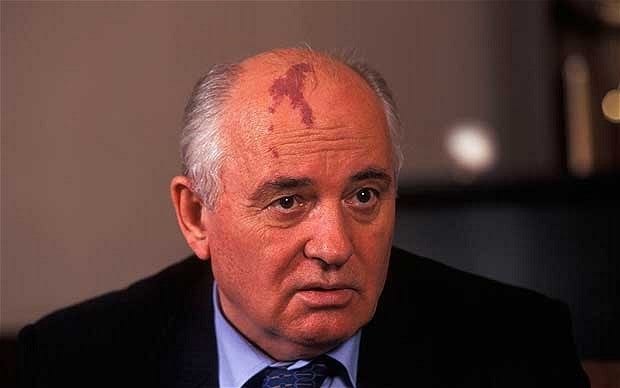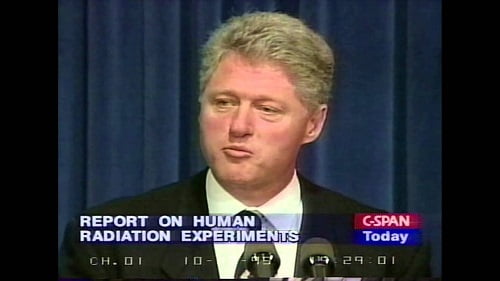On June 12, 1994, Nicole Brown Simpson and Ron Goldman were found stabbed to death outside Nicole’s condo in the Brentwood area of Los Angeles. Simpson was a person of interest in their murders. Simpson did not turn himself in, and on June 17 he became the object of a low-speed pursuit by police while riding as a passenger in the white 1993 Ford Bronco SUV owned and driven by his longtime friend Al Cowlings. TV stations interrupted coverage of the 1994 NBA Finals to broadcast the incident live. With an estimated audience of 95 million people, the event was described as “the most famous ride on American shores since Paul Revere’s”.
The pursuit, arrest, and trial of Simpson were among the most widely publicized events in American history. The trial, often characterized as the Trial of the Century because of its international publicity, likened to that of Sacco and Vanzetti and the Lindbergh kidnapping, culminated after eleven months on October 3, 1995, when the jury rendered a verdict of “not guilty” for the two murders. An estimated 100 million people nationwide tuned in to watch or listen to the verdict announcement. It was such a seismic moment in history that trading on the New York Stock Exchange dipped by 41 per cent, President Clinton was briefed on security measures should rioting occur and Domino’s Pizza reported a spike in orders 15 minutes before the verdict and not one single order throughout the entire United States while it was read.
Following Simpson’s acquittal, no additional arrests or convictions related to the murders were made.
Despite always protesting his innocence (see LAPD interrogation), Simpson’s acquittal – amid claims of racism, tampered evidence and a bungled investigation by the Los Angeles Police Department – was regarded by most as one of the worst miscarriages of justice of all time. OJ was finally jailed in 2008 for robbery and kidnap offences and was released from prison on October 1, 2017 with parole.
Immediate reaction to the verdict was known for its division along racial lines: a poll of Los Angeles County residents showed that most African Americans there felt that justice had been served by the “not guilty” verdict, while the majority of whites and Latinos expressed an opinion that it had not. The black community was influenced by having suffered in Los Angeles from oppression by the majority-white, discriminatory police department. O. J. Simpson’s integrated defense counsel team included Johnnie Cochran, Robert Kardashian, Robert Shapiro, and F. Lee Bailey. Marcia Clark was the lead prosecutor for the State of California.
At the time of O.J. Simpson’s acquittal, polls revealed that a majority of Americans thought he was guilty — a detail not made abundantly clear in The People v. O.J. Simpson: American Crime Story. It’s true that the public was split on the issue, largely based on race, as the show portrayed. But the vast majority of Americans thought Simpson was guilty, and according to polls, that number has risen in the years since the verdict. But there have always been holdouts. Some Americans are convinced that he didn’t do it, and the below O.J. Simpson conspiracy theories could explain why.
According to a 2016 poll, 83% of white Americans and 57% of black Americans believe Simpson was guilty of the murders. If so, they must have some other explanation. Led by Johnnie Cochran, the defense threw out a number of possibilities in court, including the notorious LAPD theory: That the cops, led by officer Mark Fuhrman, had planted the evidence to convict Simpson (Furhman vehemently denies this to this day). Combine that with the glove try-on — “If it it didn’t fit, you must acquit!” — and Cochran won the trial.
It is undeniable that the defense teams contentious racism strategy was decisive in the verdict. The LA police themselves were embroiled in a whole series of ethics scandals, from the beating of Rodney King to the Ramparts corruption scandal. In light of the racial animus of the time, it is not hard to see why the allegations that the police had framed a black icon like Simpson resonated so strongly with the jury.
We will see how the outline of the case for OJ’s innocence came from the LAPD itself, how puzzling anomalies in the forensics cannot be reconciled with Simpson’s guilt and how the true story about the brutal slaying of two young people in one of LA’s most affluent neighborhoods may be hiding Hollywood’s darkest secret.
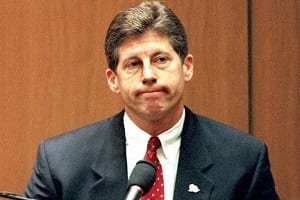 Contrary to popular belief, the idea that OJ Simpson was framed by racist police detectives did not originate with his expensive, all-star defense team. It actually came from a whistleblower within the LAPD itself. A journalist by the name of Stephen Singular was first approached about the OJ Simpson case just a few weeks after the murders. Singular, who had previously written a book about the murder of jewish talk radio host Alan Berg by a neo-Nazi group called The Order, was contacted by an anonymous source within the LA police with a disturbing story. According to the author’s own Deep Throat, a faction of extreme racist neo-Nazi police officers was operating within the LAPD. More troubling still, some of them had planted evidence in the OJ Simpson case.
Contrary to popular belief, the idea that OJ Simpson was framed by racist police detectives did not originate with his expensive, all-star defense team. It actually came from a whistleblower within the LAPD itself. A journalist by the name of Stephen Singular was first approached about the OJ Simpson case just a few weeks after the murders. Singular, who had previously written a book about the murder of jewish talk radio host Alan Berg by a neo-Nazi group called The Order, was contacted by an anonymous source within the LA police with a disturbing story. According to the author’s own Deep Throat, a faction of extreme racist neo-Nazi police officers was operating within the LAPD. More troubling still, some of them had planted evidence in the OJ Simpson case.
Months before the trial and subsequent media storm about racism and evidence tampering, Singular was given some very specific information. Firstly, an LA police detective by the name of Mark Fuhrman openly espoused extreme racist views, boasted about persecuting interracial couples and even painted a swastika on the locker of a colleague who had married a jewish woman.
On the night of the murders Fuhrman was one of the first police officers at Nicole’s Bundy Drive home. According to Singular’s source, the detective had used a piece of strict broken off the fence to pick up a bloody glove at the crime scene and place it in a blue evidence bag. Fuhrman and another detective then made an undocumented trip to OJ Simpson’s house at Rockingham in the early hours of the next morning and dropped the glove behind a fence to the side of the property. It was Fuhrman himself who then subsequently found this apparently piece of damning evidence against Simpson.
Singular was also told that a vial of OJ’s blood was in the possession of another LA police detective for several hours whilst he had free reign of the crime scene. This blood sample, which Simpson volunteered to police the day after the murders, was stored in an evidence vial with a purple cap, which indicated the presence of an anti-coagulant chemical called EDTA. Blood from this vial was then deposited at the crime scene and the bloody socks found in Simpson’s bedroom to frame him. It sounded unbelievable, and Singular was not sure at the time what to make of the sensational information.
Subsequently, almost everything Singular was first told would be validated by what unfolded in the coming months. A stick and a blue evidence bag were found on Simpson’s property and entered into evidence, Fuhrman was outed as a genocidal racist and some of the key testimony about his actions that night were shown to be false.
The famous photograph of him pointing at the bloody glove was actually shown to be taken at 4:30am, rather than 7am as Fuhrman and his fellow officers stated. That Fuhrman had made undocumented visits to the Rockingham house during the night was further bolstered by Rosa Lopez, a maid at the house next door, who told Fuhrman himself she had heard two men arguing at the property at 2am. Tellingly, Fuhrman failed to include this information in his report.
Perhaps most importantly, Singular’s information about the blood checked out. Several pieces of the most important Simpson blood evidence was found to contain EDTA, strongly indicative that that blood was planted from an evidence vial, and did not come out of a human being during the execution of the crime.
This blood evidence is still hotly disputed, and the prosecution spent a great deal of time at the trial trying to show the EDTA found in the crime scene blood was due to mistakes in the testing. But if that was truly the case, how could Stephen Singular’s source possibly have known EDTA would be mistakenly found in the blood months in advance?
During the 1995 criminal trial, much was made of the incompetent way the LAPD handled the forensic evidence in the case. Countless examples of crucial exhibits been compromised because they were not collected or documented properly were argued about in the courtroom.
Added to the credible testimony that key blood evidence was tampered with and the jury were left with the impression that the forensics in the case against Simpson simply could not be trusted.
This aspect of the case is well worn and much debated. The mainstream advocates of OJ Simpson’s guilt dismiss the doubts as insufficient to overturn what they see as the overwhelming weight of the case against their suspect.
But beyond what is often a circular argument, there are a number of inexplicable contradictions in the evidence that are far less well known, but that are very difficult to reconcile with Simpson’s guilt.
Both sides agree that at the time of the murders OJ Simpson was a middle aged man who was not in the best condition. He had bad knees and was on medication for two different forms of arthritis. He was suffering the effects the toll of his NFL playing says had taken on his body.
In order to get around the unlikely proposition that OJ could have simultaneously murdered two younger fitter adults without either calling for help, escaping or seriously injuring him in the process, the prosecution contended that Simpson murdered Nicole Brown and Ron Goldman separately.
Testimony from Detective Tom Lange casts serious doubt on this. Lange was one of the first police officers at the scene, and explained during the trial how the gate mechanism that granted access to Nicole’s house did not work properly. The intercom functioned but the buzzer to open the gate did not, meaning Nicole had to come out of the house and open the gate manually to let people in.
If Nicole had granted OJ access to the property at an earlier time, and then he had murdered her, it would mean he would have had to have let Ron Goldman into the property either during or shortly after he had killed Nicole, a prospect so absurd as to be discounted.
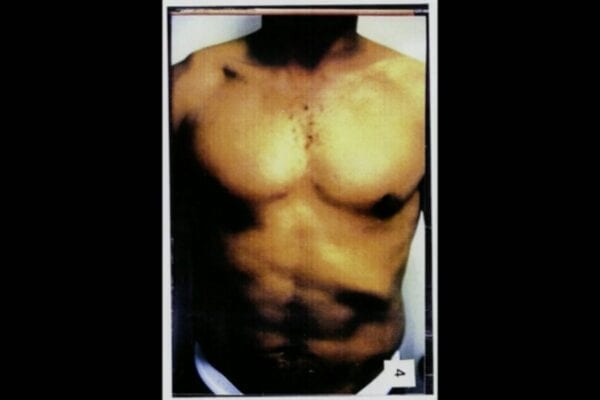
It seems more likely that it was Nicole that opened the gate for Ron Goldman, meaning the pair were both at the property when the murders commenced. This returns us to the original problem; how could Simpson have overpowered and brutally murdered two adults simultaneously without either calling for help and without sustaining any serious injuries himself?
The day after the murders, OJ was stripped to his underwear by the police and photographed. His body did not contain any signs of injury or bruising, aside from the infamous small cut to his finger. This cut was much trumpeted by the prosecution, but since there was no corresponding hole in the bloody glove, they had to concoct a speculative scenario which had Goldman pulling the stiff, tight fitting leather glove off whilst been stabbed to death.
Both Goldman and Nicole clearly struggled with their killer, Ron’s body was covered in defense wounds, his knuckles were battered and even the soles of his shoes had knife cuts on them where Goldman had kicked his assailant. It is barely conceivable that Simpson on his own could have murdered them separately and not sustained major injuries, so the notion that he did so simultaneously seems impossible. Could there have been more than one killer?
Evidence for multiple killers is clearly contained in Dr Irwin Golden’s autopsy report. Golden was the forensic pathologist who performed the autopsies on the victims, and concluded two different types of knife were used, a single bladed knife and a more serrated double bladed dagger like weapon.
Golden’s findings were highly contentious, and due to legal maneuverings by both sides at the trial he did not testify to his findings. Instead his boss was called to testify on his behalf, and he was far more equivocal about the possibility of multiple killers, admitting only that it was conceivable although he did not think it was the case. Despite this, Golden’s original findings that there were two killers are a better fit for the facts than the idea that a first time killer such as Simpson could have so cleanly dispatched two victims with a knife without himself sustaining any serious injuries.
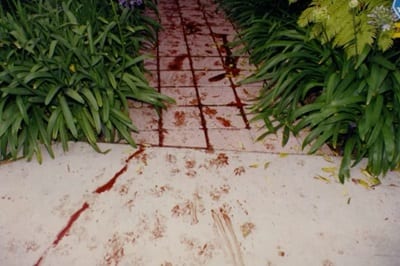 The two killer theory was also bolstered by still unidentified DNA and fingerprints found at the crime scene, untested blood spatter on Nicole’s back and what appeared to be two different sets of bloody footprints on the pathway. For most people, especially those who have consumed the mainstream material on the subject, one the most persuasive reasons to believe in Simpson’s guilt are the now infamous Bruno Magli shoes. Footprints from the distinctive and rare shoes were found in the victim’s blood at the crime scene and whilst Simpson initially denied owning a pair of the shoes, his guilt in the matter only seemed to be compounded by photographs that emerged of him from before the murders wearing a pair of the same shoes.
The two killer theory was also bolstered by still unidentified DNA and fingerprints found at the crime scene, untested blood spatter on Nicole’s back and what appeared to be two different sets of bloody footprints on the pathway. For most people, especially those who have consumed the mainstream material on the subject, one the most persuasive reasons to believe in Simpson’s guilt are the now infamous Bruno Magli shoes. Footprints from the distinctive and rare shoes were found in the victim’s blood at the crime scene and whilst Simpson initially denied owning a pair of the shoes, his guilt in the matter only seemed to be compounded by photographs that emerged of him from before the murders wearing a pair of the same shoes.
The Bruno Magli’s are now routinely trotted out as a kind of definitive clincher in the case against Simpson, but a more thorough look at the real evidence reveal it to be somewhat less convincing. As author TH Johnson discovered, the actual uniqueness of the shoes is overstated. Whilst the shoe upper itself was very rare, perhaps as little as 200 pairs of their kind in the United States, the soles of the shoes were far more common. Johnson tracked down the manufacturer and found that they had sold the same sole designs to dozens of other shoe producers, meaning they could have been attached to many thousands of pairs of shoes.
Johnson also found that the size of the shoe sole in question was smaller than a tracing of Simpson’s feet he obtained from prison; if OJ could have gotten them on his feet at all they would have been tight-fitting and uncomfortable. The prosecution scenario involving the shoes was always unconvincing. Why would Simpson chose to change out of the sneakers he had been wearing earlier in the evening into a pair of expensive and traceable shoes to go and commit a murder? Especially a pair of shoes that quite clearly must have been extremely uncomfortable for him to wear.
We would also have to accept that Simpson so expertly disposed of nearly all of the evidence against him, his bloody clothes, the murder weapon, and the shoes that not a trace of it has ever been found, yet foolishly left a pair of bloody socks in the middle of his bedroom floor. Like much of the other blood evidence, the blood on the socks was not discovered until several weeks after they were entered into evidence. At the trial, Herbert Macdonell, a blood splatter expert, testified that the pattern of the stains on both sides of the sock indicated the blood had been pressed onto them when they were laying flat, a sure sign that the blood had been planted.
The prosecution naturally tried to counteract this claim, but other logical gaps in the blood evidence just wouldn’t go away. If, for instance, Simpson really was the person wearing the shoes that made the bloody footprints at the murder scene, how did he then make his escape in the white Ford Bronco without leaving blood on the pedals of the car?
The paucity of blood in the Bronco was just one in a collection of similarly puzzling anomalies. Only a few drops in total were ever found in the vehicle, a near impossibility considering Simpson had to be covered in blood after the violent and prolonged knife murder of two adults just seconds earlier.
Detectives Fuhrman, Vannatter and Lange also gave conflicting testimonies on when they first observed blood in Simpson’s Bronco. Despite how small they were, Fuhrman would claim he saw the spots of blood in the dark by looking through the vehicle’s windows with a small flashlight. However at the trial, officers unconnected to the investigation testified that they did not observe any blood whilst internally inspecting the vehicle in broad daylight at the police garage. Startlingly, the vehicle was also broken into twice whilst impounded by the police, casting further suspicion on the provenance of the blood evidence inside.
OJ Simpson built his formidable reputation in the NFL by been one of the fastest running backs around. Indeed he is one of the few footballers to hold a world record in athletics, his 1967 USC track team still holding the rarely run 440 yard relay record. If the prosecution theory of the murders is correct, he translated all of that brevity to the night of June 12 1994. The now widely accepted timeline that has OJ Simpson committing the murders at Bundy Drive and returning to his Rockingham home entails Simpson doing an improbable number of things in an equally improbable short period of time.
At the trial the defense and prosecution disagreed at what times the murders actually occurred. The state’s lawyers used the testimony of local resident Pablo Fenjves, who said that he had heard Nicole Brown’s dog barking at around 10:15-10:20, to assert this was when a violent disturbance began at the property. However a recently uncovered crime scene photograph of Nicole’s watch appears to show it had broken during the attack and was stuck at 9:59. If that is the case it would probably exonerate Simpson, who was known to still be at home shortly before this, and also made a cell phone call to girlfriend Paula Barbieri at 10:03.
It is ambiguous as to whether this photo shows the time at 9:59 on the night of the murders or 9:59 the following morning when the photos may have been taken. The watch was broken when it was returned to the family, but when this occurred is unclear, leaving this piece of evidence a tantalizing mystery,
Another ear witness is neighbor Denise Pilnak, whose telephone records provide a cast iron timestamp to her testimony. Pilnak recalls immediately before she phoned her sister at 10:25 she had been stood on her porch for a while and was struck by how quiet the neighbourhood sounded. The phone records indicate the call to Pilnak’s sister ended at 10:28, and by her estimation it was not until around 5-10 minutes after this that she heard the protracted sound of dog barking emitting from Nicole Brown’s home. This is clearly the same barking Pablo Fenjves heard and it did not begin until sometime after 10:30pm.
A neatly dressed, normal looking OJ Simpson greeted his limousine driver Allan Park outside of his Rockingham home at 11:00pm. This timing is not disputed as it is timestamped by a cell phone call Park made five minutes prior to this, and also Simpson’s 11:33pm check in time at LAX airport. If the prosecution’s theory that OJ Simpson committed the murders is correct, and the dogs barking coincided with the attack, then the number of things Simpson would have had to have done in less than 20 minutes is quite startling. First he would have had to separately murder two grown adults in prolonged, extremely violent knife attacks. The attack on Ron Goldman alone may have taken up to 10 minutes based on the sheer number of defense wounds he suffered. Simpson then had to get in his Bronco and drive back to his property, a 5-10 minute drive depending on conditions.
Advocates of OJ’s guilt often cite the testimony of Jill Shively, who claimed to have seen Simpson in his Bronco making this return journey at 10:50pm. The defense team discredited Shively before the trial and she did not testify, but five minutes after her supposed sighting, at 10:55pm, limo driver Allan Park saw a large, dark figure resembling Simpson enter the house at Rockingham.
If these sightings were Simpson, it meant he had to shower or clean the blood off his hands and body, dispose of any towels or tissues he used, clean the basin or shower, stem the putative deep cut on his finger, dispose of the murder weapon, his shoes and the bloody clothes, none of which were ever found, and dress and compose himself in five minutes or less.
The next few hours of Simpson’s time are very well documented. During the drive to LAX airport he has the limo window wound down and makes small talk with Park, who describes Simpson as relaxed and chatty. On the plane to Chicago, Simpson is described by witnesses as appearing normal and approachable. Simpson signs several autographs during this time, and even talks with the pilot and signs his flight log. None of these witnesses recall any kind of visible injuries to Simpson, despite several of them getting a look at his hands. Student Stephen Valerie, sat next to OJ on the plane, even testified at the trial as to how he looked closely at Simpson’s fingers to see if he could spot his NFL championship ring, but observed no cuts or injuries.
This official timeline of OJ’s actions after the murders, whilst not impossible, looks implausibly tight. But a more fundamental problem emerges in the form of a phone call Nicole Brown made to her mother on the night of the murders, a phone call which might very well prove OJ Simpson is innocent. Shortly after the murders, Nicole’s parents Juditha and Louis Brown told investigators that Juditha had briefly talked with Nicole on the phone at 11:00pm. Earlier that evening they had dined with Nicole, her sisters and her children at LA’s Mezzaluna restaurant, before they departed for home at 8:45pm.
The senior Browns lived at Dana point in Orange County, ordinarily a 90 minute drive from the Mezzaluna, although author TH Johnson obtained highways data for the night that showed a combination of congestion and road works had reduced traffic speed to less than 30 mph for several stretches of the journey. Allowing some extra time for this still makes the 11pm call feasible within the timeline of the Brown’s movements. However once it became apparent that the 11:00pm call exonerated Simpson, who was known to be departing for the airport at the time, the time of the call had to be revised.
The prosecution eventually concluded the call took place at 9:40pm, as this better fitted their scenario that OJ Simpson had committed the murders. But it clearly contradicted the movements of the Browns, as it entailed them making a minimum 90 minute journey in less than an hour, an impossibility particularly in light of the traffic conditions.
This puzzling aspect of the case is unexplained to this day. Although the prosecution entered a pasteboard featuring what was purported to be a cropped photograph of Juditha Brown’s phone bill showing the 9:40pm call, the actual verified phone records remain unreleased. The fact a piece of evidence so pivotal that it could definitively prove OJ Simpson did not commit the murders is still unavailable for scrutiny more than 25 years after the crimes is troubling to say the least.
Cocaine and Blue Eyes
Whatever really happened that night at Bundy drive one dark and unsettling question has not only remained unanswered, but also largely unasked – was there a drugs connection to the murders? Johnnie Cochran briefly broached a drugs angle at the trial when he asked about Nicole’s neck would resembling the Colombian necktie, a form of killing favored by drugs gangs that involves slitting the throat from ear to ear.
Aside from this, both sides retreated from any connections the drugs underworld may have had in the crime and the subject was not mentioned again. However, from a look at the various key players involved, and both OJ and victims’ social circles, it’s quite clear that the environment in which the crimes committed was steeped in drugs.
Perhaps it is the sheer scope and breadth of the drugs connections that made both sides reluctant to touch the subject; many unifying truths could be uncovered by delving too deep into that world. But with the murders occurring in a time and a place that was an epicenter of drugs related violence it would clearly be foolish to dismiss the avenue of investigation altogether.
It was well known in Hollywood circles that OJ Simpson and Nicole Brown were heavy cocaine users. But it appears for both of them their involvement in drugs had progressed beyond the kind of casual use you would except in the world they lived in. Nicole, according to friends, was just days from entering rehab at the time of her death. Like her friend Faye Resnick, it appeared her drug use was becoming reckless and dangerous. On one occasion the pair even freebased coke whilst driving through LA.
OJ himself had been suspected or caught actually dealing drugs both before and after the murders. In 1975 he was the target of an FBI sting when he was suspected of dealing coke to NFL players. Simpson’s friend and confident Al Cowlings, who was in the White Bronco with OJ during the famous slow speed chase down a south LA highway, also used to work for Mafia drug kingpin Joey Ippolito.
Caught up in that 1975 drug sting was an associate of OJ’s named Casimir Sucharski, who would later become one of a string of people to be brutally murdered around the same time as Nicole Brown and Ron Goldman.
Just three weeks after the murders at Bundy Drive, Sucharski and two others were slaughtered in Sucharski’s Florida home in what looked some kind of drug burn or hit. Whilst the connection to what happened at Bundy may be tenuous, what of the Ron Goldman’s friends Brett Cantor and Michael Nigg?
Cantor, a local nightclub entrepreneur, was a mutual friend of both Ron and Nicole. He was brutally stabbed to death a year before Goldman was also stabbed to death in remarkably similar fashion.
A year after Goldman’s death another friend of his, fellow Mezzaluna employee Michael Nigg, was gunned down at a cashpoint in LA. Nothing was taken and it appeared the motive was not robbery. That four middle class white people from the same social circle, all from solid family backgrounds, would be brutally murdered gangland style in a relatively short two year period seems suspicious, equally so since none of the murders have ever been solved. Could there be a connection?
Continued on next page…


